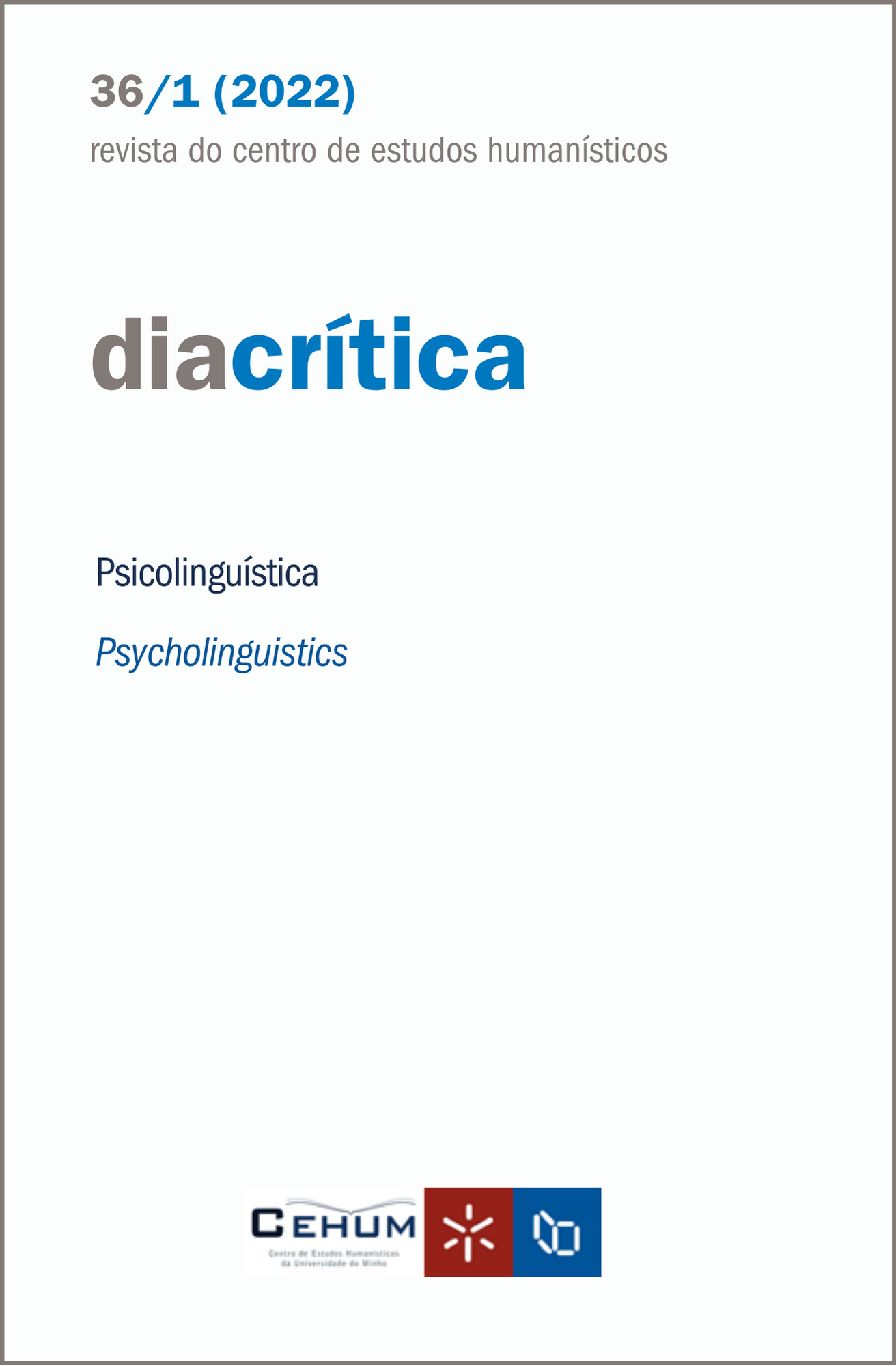Aceitabilidade de sentenças de tópico-comentário em PB e em inglês: um estudo psicolinguístico
DOI:
https://doi.org/10.21814/diacritica.4778Palavras-chave:
Tópico, Português do Brasil, Inglês, Julgamentos de aceitabilidade, PsicolinguísticaResumo
O presente estudo investiga estruturas de tópico-comentário e sujeito-predicado no Português do Brasil (PB), sob a luz da psicolinguística experimental, a fim de trazer suporte empírico que sustente a hipótese de que o PB seria uma língua mista, orientada tanto para a sentença quanto para o discurso, diferente do inglês, que é, indiscutivelmente, uma língua com proeminência de sujeito, orientada para a sentença (cf. Li & Thompson 1976). Investigamos estruturas de tópico geradas na base (tópico estilo-chinês), pois tais estruturas são prototípicas de uma língua onde a noção de tópico é importante e ausentes em uma língua onde a noção de sujeito é a dominante (cf. Yuan 1995), além de estruturas de tópico geradas via movimentação sintática (topicalização). O experimento de julgamento de aceitabilidade demonstrou que o comportamento dos falantes de PB e de inglês foi significativamente diferente durante a tarefa proposta, o que pode indicar que as línguas não se encaixam na mesma tipologia, quanto a sua orientação. O resultado do teste com o grupo bilíngue confirmou, ainda mais, as suposições iniciais, de que PB e inglês não enxergam o tópico da mesma maneira. Tais resultados sugerem que o PB deva ser caracterizado como uma língua onde ambos, tópico e sujeito, são noções importantes (cf. Pontes 1987, entre outros).
Referências
Berlinck, R., Duarte, M. E. L., & Oliveira, M. (2015). Predicação. In M. A. Kato, M. Nascimento (Orgs.), Gramática do Português Culto falado no Brasil: A construção da sentença (Vol II, pp. 81–149). São Paulo: Ed. Contexto.
Chen, C. (2011). The influence of Chinese topic prominence construction on English acquisition – a study on non-English majors and English majors at a Chinese college. Kristianstad University, Sweden. Consultado em http://www.diva-portal.org/smash/get/diva2:429120/FULLTEXT01.pdf
Cinque, G. (1977). The movement nature of left dislocation. Linguistic Inquiry, 8, 397–412.
Duarte, I. (1996). A topicalização no português europeu: Uma análise comparativa. In I. Duarte & I. Leiria (Eds.), Actas do Congresso Internacional sobre o Português (pp. 327–360). Lisboa: APL/Colibri.
Galves, C. (2001). Ensaios sobre as gramáticas do português. Campinas: Editora da Unicamp.
Kato, M. (2006). Comparando o português da América com o português de Portugal e com outras línguas. Museu da língua Portuguesa. Consultado em https://www.museudalinguaportuguesa.org.br/wp-content/uploads/2017/09/Comparando-o-port-da-Ame%CC%81rica-com-port-Portugal.pdf
Kenedy, E. (2002). Aspectos estruturais da relativização em português: Uma análise baseada no modelo raising (Dissertação de Mestrado, UFRJ, Rio de Janeiro).
Kenedy, E. (2011). Tópicos e Sujeitos no PB: Uma abordagem experimental. Revista da Anpoll, 1(31), 69–88. https://doi.org/10.18309/anp.v1i31.201 DOI: https://doi.org/10.18309/anp.v1i31.201
Kenedy, E., & Mota, C. (2012). Orientações de anáforas nulas e pronominais para sujeitos e tópicos no PB. Revista Linguística, 8(2), 159–172. https://doi.org/10.31513/linguistica.2012.v8n2a4556
Kenedy, E. (2014). O status tipológico das construções de tópico no português do Brasil: uma abordagem experimental. Revista da ABRALIN, 13(2), 151–183. https://doi.org/10.5380/rabl.v13i2.39614 DOI: https://doi.org/10.5380/rabl.v13i2.39614
Li, C-N., & Thompson, S. (1976). Subject and topic: A new typology of language. In C-N. Li (Ed.), Subject and topic (pp. 457 – 489). New York: Academic Press.
Maia, M. (1997). The processing of object anaphora in Brazilian Portuguese. Révue Linguistique de Vincennes, 26, 151–172.
Negrão, E. V. (1999). O português brasileiro: Uma língua voltada para o discurso. (Tese de livre docência, USP, São Paulo).
Orsini, M. T. (2003). As construções de tópico no português do Brasil: Uma análise sintático-discursiva e prosódica. (Tese de Doutorado, UFRJ, Rio de Janeiro).
Orsini, M., & Vasco, S. (2007). Português do Brasil: Língua de tópico e de sujeito. Revista Diadorim, 2, 83–98. https://doi.org/10.35520/diadorim.2007.v2n0a3852 DOI: https://doi.org/10.35520/diadorim.2007.v2n0a3852
Pontes, E. (1987). O tópico no Português do Brasil. Campinas: Ed. Pontes.
Silva, C.G.C. (2015). A interface prosódia-sintaxe na produção e no processamento das estruturas de tópico e SVO (Tese de Doutorado, UFJR, Rio de Janeiro).
Silva, A. (2017). Processamento prosódico na compreensão e produção de estruturas de tópico e sujeito no Português brasileiro (Dissertação de Mestrado, UFJF, Juiz de Fora).
Weskott, T., Horning, R., & Webelhuth, G. (2019). On the contextual licensing of English locative inversion and topicalization. In S. Featherston, R. Hörnig, S. von Wietersheim & S. Winkler (Eds.), Experiments in focus (pp. 153–182). Berlim: De Gruyter https://doi.org/10.1515/9783110623093-007 DOI: https://doi.org/10.1515/9783110623093-007
Xu, H. (1999). DRT-Analysis for topic-comment constructions in Chinese. University of the Saarland, Germany. Consultado em http://www.coli.uni-saarland.de/publikationen/softcopies/Xu:1999:DAT.pdf
Yuan, B. (1995). Acquisition of base-generated topics by English-speaking learners of Chinese. Language Learning, 45, 567–603. https://doi.org/10.1111/j.1467-1770.1995.tb00455.x DOI: https://doi.org/10.1111/j.1467-1770.1995.tb00455.x
Downloads
Publicado
Como Citar
Edição
Secção
Licença
Direitos de Autor (c) 2023 Lorrane da Silva Neves Medeiros Ventura

Este trabalho encontra-se publicado com a Creative Commons Atribuição-NãoComercial 4.0.










